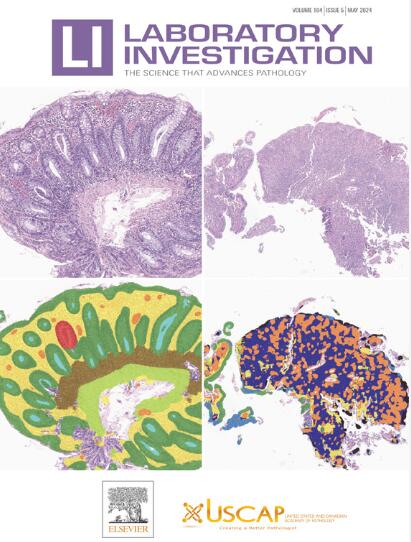Quantitative Analysis of Rectal Cancer Biopsies With the Digital Pathology Segmentation Algorithm QuantCRC Associates With Therapy Response and Recurrence
IF 4.2
2区 医学
Q1 MEDICINE, RESEARCH & EXPERIMENTAL
引用次数: 0
Abstract
We examined whether QuantCRC, a digital pathology segmentation algorithm, on pretherapy rectal cancer biopsies is associated with pathologic complete response (pCR) to neoadjuvant therapy, recurrence-free survival (RFS), and transcriptomic spatial profiling. QuantCRC was evaluated in an observational cohort of 288 pretherapy biopsies and a separate validation cohort of 37 pretherapy biopsies of rectal adenocarcinoma from patients undergoing neoadjuvant therapy. Associations between QuantCRC features and clinical outcomes, pCR, and RFS were analyzed using multivariable logistic regression and Cox proportional hazards modeling, respectively. QuantCRC variables were also correlated with transcriptomic digital spatial profiling of 37 pretreatment biopsies of cT3N+ rectal cancer. QuantCRC-derived lymphocytes per square millimeter of tumor epithelium (tumor-infiltrating lymphocytes [TILs]) was significantly associated with pCR (multivariate odds ratio, 1.05; 95% CI, 1.02-1.10; P = .038). QuantCRC-derived TILs were significantly higher in pretherapy biopsies with pCR (91.3 vs 55.9 lymphocytes/mm2; P = .004). The validation cohort confirmed that only QuantCRC-derived TILs in pretherapy biopsies of rectal cancer were significantly associated with complete response to neoadjuvant therapy. QuantCRC %high tumor grade was independently associated with worse RFS (multivariate hazards ratio, 1.27; 95% CI, 1.09-1.47; P = .002). Patients with ≥10.1% high tumor grade identified by QuantCRC had significantly reduced RFS (5-year RFS 69% vs 83%, log-rank P = .007). Transcriptomic profiling identified high interleukin (IL)-6/JAK/STAT3 signaling within immune cells to be associated with worse RFS (adjusted P = .01). Tumors with low IL-6/JAK/STAT3 expression within immune cells had significantly higher TILs compared with tumors with high expression (median, 152 vs 97 TILs/mm2; P = .039). Biopsy-adapted QuantCRC in pretherapy rectal cancer may be helpful in identifying patients who achieve pCR and are at risk for recurrence.
用数字病理分割算法定量分析直肠癌活检与治疗反应和复发的关系。
我们研究了治疗前直肠癌活检的数字病理分割算法QuantCRC是否与新辅助治疗的病理完全缓解(pCR)、无复发生存(RFS)和转录组空间谱相关。QuantCRC在288例治疗前活检的观察性队列和37例接受新辅助治疗的直肠腺癌治疗前活检的单独验证队列中进行评估。分别使用多变量logistic回归和Cox比例风险模型分析QuantCRC特征与临床结局、pCR和RFS之间的关系。定量crc变量也与37例cT3N阳性直肠癌治疗前活检的转录组数字空间谱相关。quantcrc衍生淋巴细胞/ mm2肿瘤上皮(TILs)与pCR显著相关(多变量OR 1.05, 95% CI 1.02-1.10, P=0.038)。在治疗前pCR活检中,quantcrc衍生的TILs明显更高(91.3比55.9淋巴细胞/ mm2, P=0.004)。验证队列证实,在直肠癌治疗前活检中,只有quantcrc衍生的TILs与新辅助治疗的完全缓解显著相关。高肿瘤分级与较差的RFS独立相关(多变量HR 1.27, 95% CI 1.09-1.47, P=0.002)。QuantCRC鉴定≥10.1%高肿瘤分级的患者RFS显著降低(5年RFS 69% vs 83%, log-rank p=0.007)。转录组学分析发现免疫细胞内高IL-6/JAK/STAT3信号与较差的RFS相关(调整后P=0.01)。与免疫细胞内IL-6/JAK/STAT3低表达的肿瘤相比,免疫细胞内IL-6/JAK/STAT3高表达的肿瘤具有更高的TILs(中位数为152比97 TILs / mm2, P=0.039)。在治疗前的直肠癌中,活检适应的QuantCRC可能有助于识别达到pCR并有复发风险的患者。
本文章由计算机程序翻译,如有差异,请以英文原文为准。
求助全文
约1分钟内获得全文
求助全文
来源期刊

Laboratory Investigation
医学-病理学
CiteScore
8.30
自引率
0.00%
发文量
125
审稿时长
2 months
期刊介绍:
Laboratory Investigation is an international journal owned by the United States and Canadian Academy of Pathology. Laboratory Investigation offers prompt publication of high-quality original research in all biomedical disciplines relating to the understanding of human disease and the application of new methods to the diagnosis of disease. Both human and experimental studies are welcome.
 求助内容:
求助内容: 应助结果提醒方式:
应助结果提醒方式:


